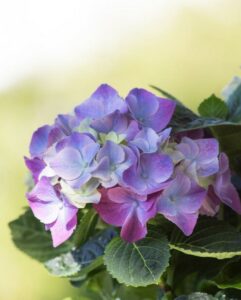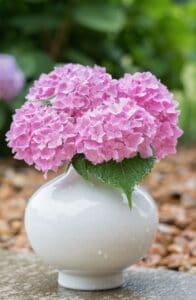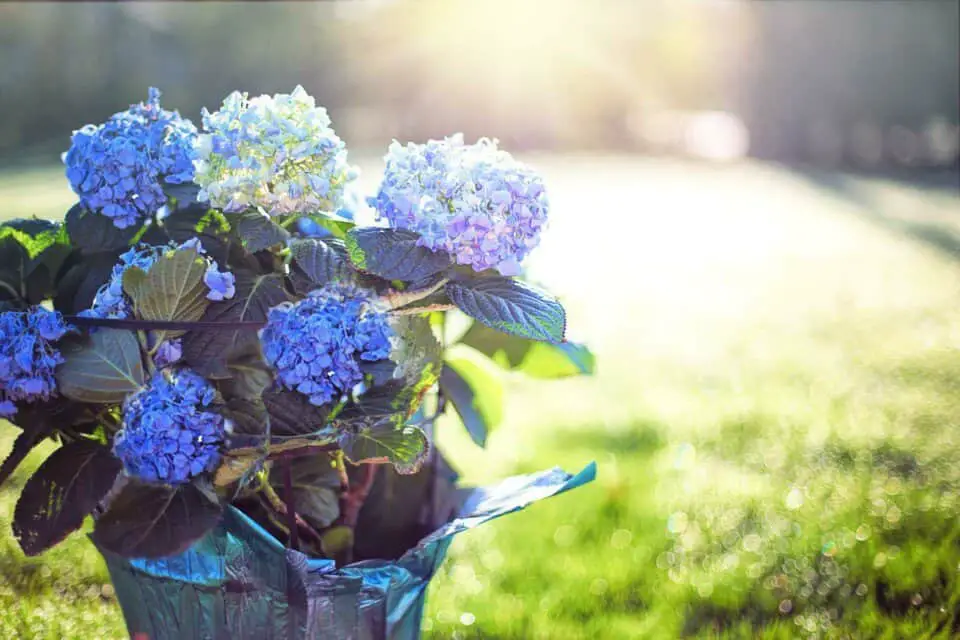Some links in the post are affiliate links and I get a commission from purchases made through some links found in the post.
Hydrangeas come in various varieties and cultivars, making them popular for gardeners. As a result of their widespread appeal, plant breeders have been driven to develop more stunning varieties.
The categories and characteristics of each type are described in the following list. There are numerous advantages to growing hydrangeas in the garden, and gardeners have known this for generations.
Early spring or summer brings a burst of floral and occasionally foliar interest that lasts until fall. Plants of this family are generally low-maintenance and offer a high return on investment, making them an excellent choice for beginners.
One thing that all plants require, regardless of species, is a constant supply of water for the duration of the growing season. Hydrangea derives from the Greek words Hydor, which means water, and Angus, which means jar or container.
The seed capsules’ resemblance to small Grecian water jars inspired the name’s literal translation: “water jar.” Hydrangeas, with their blooms, are classified as shrubs.
Hydrangeas may grow up to 15 feet tall, and they can easily take over a whole yard.
They can grow 25 inches or more per year till they reach maturity. A “tree” plant is expected to grow at least 3 inches wide and 13 feet tall by the time it is 4 1/4 feet tall.
Clusters of brightly colored hydrangea blossoms make them immediately identifiable. Many diverse species have the same lovely foliage and flowers, but they are all distinct.
Hydrangeas are an excellent choice for a garden plant because of their enormous and vibrant blooms. Mixing and matching the various bloom colors available in hydrangeas is easy because there are such wide varieties.
Nevertheless, the size of hydrangeas can vary considerably based on the type.
For example, understanding how big hydrangeas grow will help you select plants of similar size to create a more consistent hedgerow or avoid severe differences in size.
You’ll find information on the average height and spread of several hydrangea varieties and suggestions for speeding up the growth of slow-growing hydrangeas.
Type of Hydrangea
 a rise in body mass
a rise in body mass- Hydrangeas with broad, flat leaves
- 10 feet in height and breadth on average
- Hydrangeas with oak-leaf leaves
- Hydrangeas with a rounded shape
- The five-foot-plus average height as a maximum
- Panicle hydrangeas typically grow to 12 to 15 feet, but they can grow as high as 25 feet. An 18-inch panicle might be expected.
- Hydrangeas that Climb Six-foot-wide by fifty-foot-tall
- All the types of hydrangeas have slightly varied growing conditions and a distinct height-to-width ratio variation.
How Long Does it Take for a Hydrangea to get Full Size?
Hydrangeas are fast-growing shrubs, but it can take up to two years to reach their peak size. Some individuals mature at a faster rate than others do. Hydrangeas are simple to cultivate and may flourish in any setting.
Even better, there are such wide varieties that you can enjoy a wide range of those massive, beautiful blooms throughout the summer. Your hydrangeas can live for many years if you take good care of them.
During the growth season, administer one inch of water every week. Water deeply three times each week to promote root development.
Large and smooth hydrangeas need more water than the other species, although all types benefit from constant hydration.
Rather than drenching the flowers and leaves, use a soaker hose to water the lawn thoroughly.
Regarding rapid growth, hydrangeas are classed as 25 inches or more per year till they reach maturity. A “tree” plant is expected to grow at least 3 inches wide and 13 feet tall by the time it is 4 1/4 feet tall.
How Much Space Does a Hydrangea Need?
Choosing a place with early sun and dappled afternoon shadow is critical when it comes to planting, according to McEnaney.
Leaving hydrangea leaves out in the sun for too long might cause them to burn. Well-drained loam—soil that contains equal parts clay, silt, and sand—is also an important consideration.
Well-drained soil is ideal for this plant, according to McEnaney. When dealing with clay or sand, ensure that you’re modifying the soil, so it drains well and retains sufficient water.
The hydrangea can stretch its branches out fully in the ideal location. Some hydrangeas can produce blooms that are six feet across.
Before planting, check the plant’s tag to see how big it will grow. “You want to ensure that there is space for airflow,” McEnaney adds while planting hydrangea. This allows the plants to breathe and prevents mildew.
How do you get a Hydrangea to Grow Bigger?
Hydrangeas are a perennial favorite thanks to their large, showy blooms and vibrant hues. These methods will help your plants produce even more beautiful flowers in summer and fall.
Hydrangeas in the Ground
You may save time and money by studying the basics of hydrangea planting with other things in your garden.
You’ll be able to enjoy enormous, colorful hydrangea blossoms for years to come if you choose the perfect place, prepare the soil properly, and plant correctly.
Hydrangea Planting Season
Fall is the best season to grow hydrangeas, followed by the beginning of spring. To allow the shrub enough time to create a robust root system, you should wait until after it has bloomed.
For optimal results, sow seeds in the early morning or late afternoon. This will reduce heat stress. As the plant matures, it will be easier to maintain if adequately hydrated.
Best Hydrangea Soil for your Area
 Hydrangeas flourish in soils rich in organic matter. When it comes to preventing water damage, proper drainage is essential. Hydrangeas prefer damp soil, but they will die if the soil becomes too wet.
Hydrangeas flourish in soils rich in organic matter. When it comes to preventing water damage, proper drainage is essential. Hydrangeas prefer damp soil, but they will die if the soil becomes too wet.
Root rot can be caused by moist, poorly draining soils. Your hydrangeas might die in a matter of weeks. You may want to increase the quality of your soil by mixing in plenty of compost before you plant.
Hydrangea Care Advice
The hydrangea’s flowers and foliage may appear delicate, but they don’t require much gentle, loving care. Follow the advice in this article to keep hydrangeas in excellent condition.
- Throughout the growing season, administer one inch of water every week. Water deeply three times each week to promote root development. Large and smooth hydrangeas need more water than the other species, although all types benefit from constant hydration. Rather than drenching the flowers and leaves, use a soaker hose to water the lawn thoroughly. Hydrangeas will not wilt as much if flooded early in the day.
- To keep your hydrangeas’ soil cool and moist, mulch the surrounding area, enriching the soil with nutrients and improving its texture.
- Fertilize your hydrangeas according to their specific requirements. As a result, the application timing for each variety will be different. Soil testing is the best method for determining your particular fertilizer requirements.
- Fertilize bigleaf hydrangeas in March, May, and June.
- Oakleaf and panicle hydrangeas should receive two treatments in April and June.
- Fertilize smooth hydrangeas only once in late winter.
Crop protection is more successful when using pest-resistant cultivars. Leaf spot, blight, wilt, and powdery mildew can affect hydrangeas.
Hydrangeas, which are typically pest-free, may attract pests due to stress. The best defense against hydrangea pests is proper hydrangea care.
What Can you do if your Hydrangea Gets too Big?
It’s possible to dig up the hydrangea and divide the plant or to relocate it away from roadways and walkways.
Remove any remaining stems by following them to the ground or cutting them off where they meet another branch. You can see through the plant’s leaves for a limited time.
Remove the hydrangea from its current place and relocate it somewhere where it can grow as large as its genetics dictate.
As a home landscaper or gardener, acknowledging that we don’t have complete control over a plant is one of the most challenging aspects of the job.
The tree may have been planted in the wrong area, or its size wasn’t expected. Pruning it back to make it smaller isn’t the solution.
Hydrangeas come in a wide variety of hues and sizes. Let us assist you in locating one that requires no management at all.
Relocate for a While
Myers recommends moving your hydrangeas to a new area if you can’t get them to bloom.
When it comes to hydrangeas, it’s essential to keep an eye on the present growing circumstances, and if they’re in an area that’s too wet or too shady, it’s time to relocate them.
Concerned about plant weight? We suggest picking some of the larger flowers and bringing them indoors.
Maintenance is Critical
It’s possible to control the size of your hydrangea flowers, according to Myers. According to her, drought-tolerant roots and hardier stems are encouraged by watering hydrangeas profoundly but less frequently.
In addition, trimming stems that are broken or damaged as soon as possible can promote healthy growth and better blooms.
Final Thoughts
 Established hydrangeas demand well-drained soil, whereas newly planted ones require a little more water. Allow the dam to fill and drain before re-watering it again.
Established hydrangeas demand well-drained soil, whereas newly planted ones require a little more water. Allow the dam to fill and drain before re-watering it again.
Following that, “Get your hands grimy,” ” Dip your finger past the first knuckle. Make sure it’s well-watered if it’s dry. Leave it alone if it’s damp or wet.
Depending on how much rain falls in your area and how hot it gets during the summer, Daily or biweekly watering may be required. Or you may just need to water once a week. Look at the soil, and you’ll know what to do..


